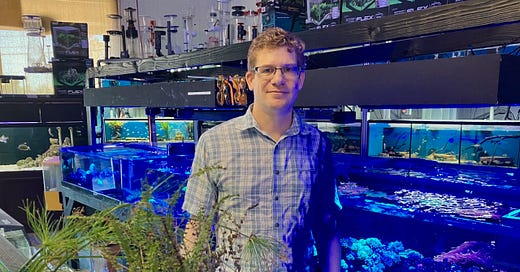Raising Corals in the New Age of Aquaria
In the U.S. alone, nearly 3 million homes have a saltwater aquarium. And globally, the market is worth billions of dollars. Could this booming hobby become a force for ocean conservation?
Dear Friends,
Today, we’re taking a break from the season’s food-centric theme to offer you something a little different: a peek into the colorful and fascinating world of saltwater aquaria—specifically, home aquarists who grow and maintain corals.
But there’s more to the story than the craft of coral husbandry, as our writer points out. Given the dangers facing coral reefs, and their alarming die-offs from climate disruption, one might think that international laws should prohibit the trade of corals altogether. Yet according to some reports, the legal trade of farmed corals does not significantly threaten wild reefs. In fact, some conservationists maintain that farming corals may be the best way to save some species from utter extinction. And the world’s home aquarists—more than 6 million and counting—could become coral’s biggest advocacy group.
We hope you’ll enjoy reading “Raising Corals in the New Age of Aquaria,” written by Contributing Editor .
We always welcome your thoughts and suggestions, which you can offer in a comment, by tagging us in Substack Notes, or via email. Thank you for reading and sharing our stories, for supporting our work with a paid subscription if you can, and for being such a loyal part of the Craftsmanship community.
Sincerely,
Todd Oppenheimer
Publisher & Editor-in-Chief, Craftsmanship Magazine

Raising Corals in the New Age of Aquaria
by
One does not expect to encounter a gold-spotted acanthophyllia in a San Jose strip mall. But the colorful and unusual Indonesian coral (a handball-sized specimen can retail for as much as $1,350) sits tucked into a tank at Clear Water Aquarium on Saratoga Ave, right between a warehouse and a Vietnamese pho shop.
Aquarist Ed Deane, an expert at the craft of growing corals in saltwater aquariums, reaches into the water and points to the specimen. It looks like a psychedelic cupcake. “Acanthophyllia are not particularly rare,” says Deane, “But the coloration this one has, you're not going to see very often.
Oceanographer Silvia Earle once described coral reefs as “a jeweled belt around the middle of the planet.” My own understanding of them is rudimentary. I know they are “colonial” and “sessile” (i.e., staying in one place) organisms, composed of fragile little animals called polyps that excrete calcium carbonate to form distinctive, sculpture-like shapes. The truth, as always, is more nuanced.





